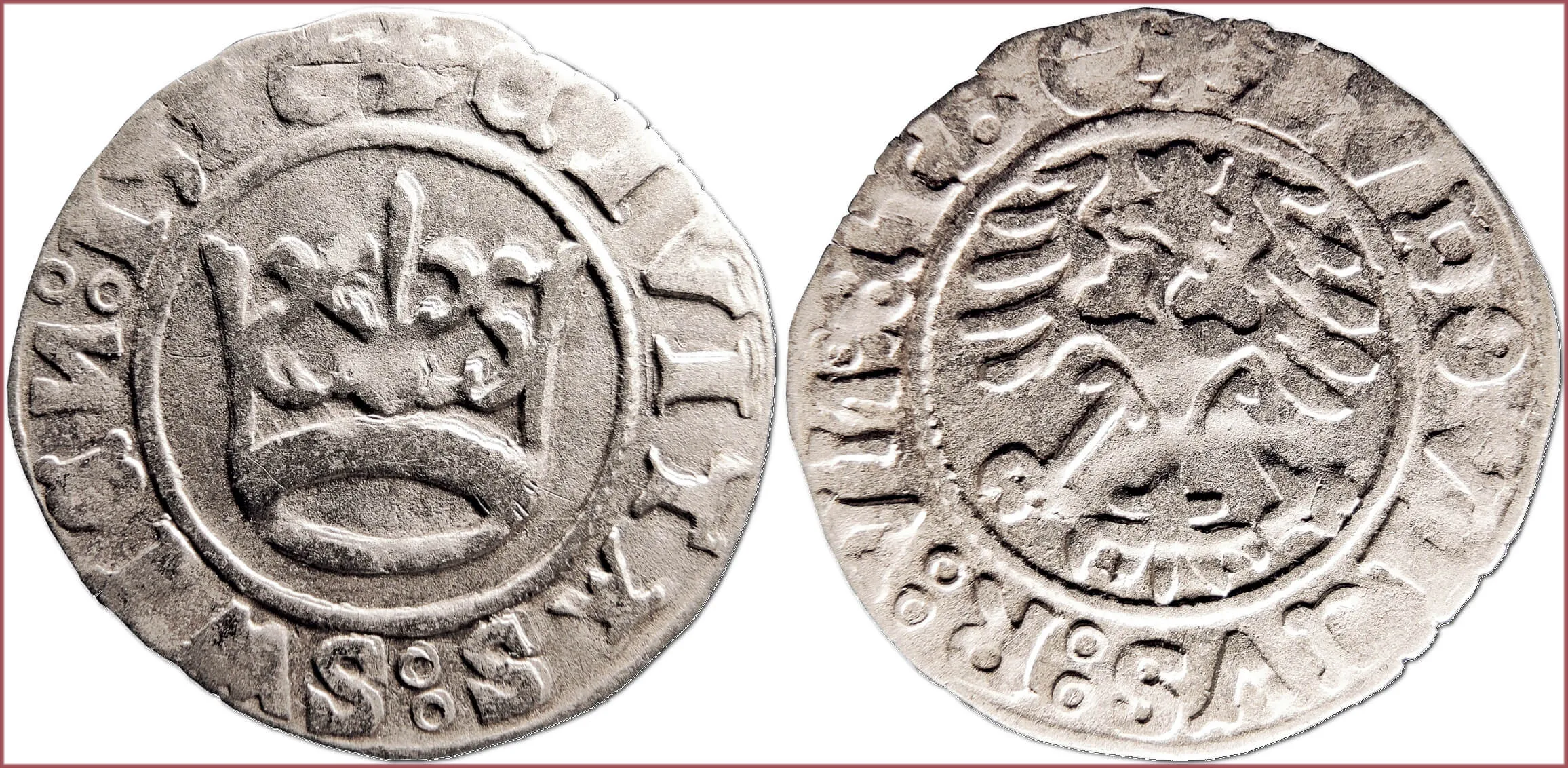PÓŁGROSZ ŚWIDNICKI: COIN OF SILESIA
Półgrosz świdnicki, 1526: city of Świdnica (Silesia)
Coin produced in the Silesian city of Świdnica (Bohemia) for use on the territory of Poland (with the aim of destabilizing money circulation).
Ruler: Louis II of Hungary (Ludwik II Jagiellończyk) — King of Hungary, Croatia and Bohemia from 1516 to 1526.
CIVITAS SWIDN 1526: the city of Świdnica, 1526.
Royal crown.
LVDOVICVS R VN ET BO: Louis King of Hungary and Bohemia.
Coat of arms of the Kingdom of Poland (crowned white eagle).
In essence, this coin is a contemporaneous forgery that was mass-produced at the state level for a long time.
- Silver: 18 mm - 0.81 g
- Reference price: 11$
COIN PÓŁGROSZ ŚWIDNICKI — WHERE & WHEN (coins catalog: by names & emitents)
- ŚWIDNICA (city in Silesia): półgrosz świdnicki
PÓŁGROSZ ŚWIDNICKI as coin name.
Półgrosz świdnicki (Swidnica polgrosz, 1/2 groschen) is a small Silesian silver coin minted during 1517-1526 in the city of Świdnica (Kingdom of Bohemia at that time) by the King of Hungary and Bohemia Ludwik II Jagiellończyk (Louis II of Hungary) in order to harm the money circulation of the neighboring Poland. Today, the city of Świdnica is located on Polish territory.
In world numismatics, półgrosz świdnicki is not just an ordinary coin, but a whole phenomenon: non-standard, interesting, in some ways even instructive...
The thing is that they were minted in Silesia, but, first of all, they looked exactly like the półgrosz koronny of neighboring Poland (with the exception of a different legend and a slightly lower quality of silver and weight — the largely illiterate population often failed to notice the change). Secondly, they were used precisely on the lands of Poland, not in Silesia.
The production of coin forgeries was not uncommon in Medieval Europe. Quite often, fraudsters produced copies of certain silver coins made of copper or silver of lower quality. There was a significant weight loss. But in this case, there was not only the production of fakes at the state level on a very serious scale, but also a deliberate failure to maintain complete similarity with the original. Interestingly, the design of the półgrosz świdnicki was kept identical to the design of the original półgrosz koronny, but the legend was not just slightly adjusted, but replaced with a completely different text. Moreover, a completely different king and issuer is indicated! — Instead of "MONETA SIGISMVNDI - REGIS POLONIE" ("Coin of Sigismund - Kingdom of Poland"), the półgrosz świdnicki featured the legend "LVDOVICVS R VN ET BO - CIVITAS SWIEN" ("Louis King of Hungary and Bohemia - City of Świdnica").
It is about the fact that it was, in essence, large-scale, mass production of fakes by Silesia to the detriment of the economy of the neighboring state and for the sake of political destabilization.
Almost immediately after the appearance of this extremely dangerous phenomenon (we are talking about artificially induced monetary inflation), they began to fight it. In the first stages, the harmful coin was withdrawn from circulation. It was banned for use and importation from Silesia. The effectiveness of the solution turned out to be too low. Then they stopped allowing Silesian merchants into the territory of Poland altogether, and introduced severe punishments for the distribution of counterfeits. Despite all this, for almost 10 years it was not possible to defeat the półgrosz świdnicki. In the end, they were allowed to use them, but at twice the lower rate.
It all ended with the final complete removal of the coin with its subsequent disposal at Polish mints. Despite the destruction (melting) of millions of copies, the półgrosz świdnicki still, after 5 centuries, is not considered a rarity in numismatic collections. This speaks of the unprecedented scale of Ludwik II Jagiellończyk's adventure.
The coin name półgrosz świdnicki indicates the center of issue: the city of Świdnica (modern Poland; until 1526 — Bohemia, Holy Roman Empire).











